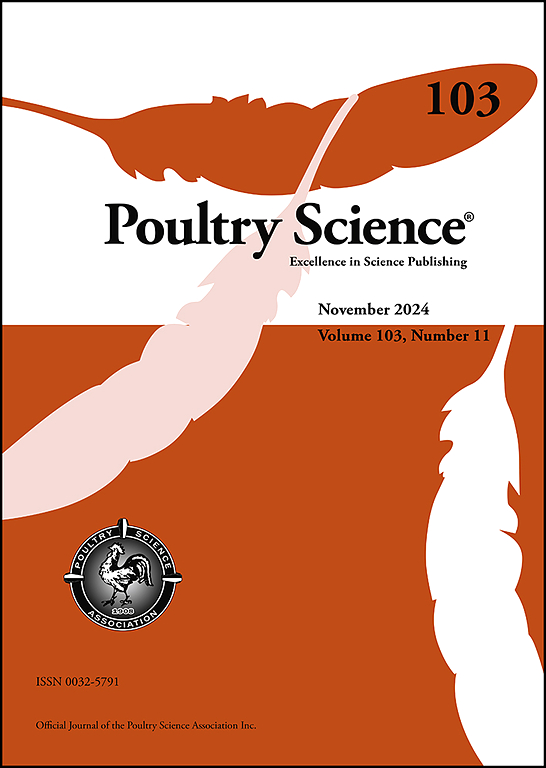展霉素对鹌鹑肌肉细胞的影响及微生物群介导的恢复潜力。
IF 4.2
1区 农林科学
Q1 AGRICULTURE, DAIRY & ANIMAL SCIENCE
引用次数: 0
摘要
真菌毒素通过损害免疫力和诱发各种毒性,对牲畜的健康和生产力构成重大威胁。本研究探讨了特定芽孢杆菌菌株减轻霉菌毒素引起的家禽细胞肌肉损伤的潜力。用常见真菌毒素展霉素处理鹌鹑肌肉克隆7号(QM7)肌肉细胞,诱导细胞损伤。随后,用候选微生物菌株B. subtilis和B. velezensis处理受损的QM7细胞。我们的研究结果表明,展霉素治疗可提高应激诱导基因表达和凋亡标志物,同时破坏正常的成肌细胞分化,这可以通过改变配对框7 (PAX7)和肌源性分化1 (MyoD)的表达模式和肌管形成受损来证明。值得注意的是,用芽孢杆菌菌株处理显著降低了这些负面影响,减少了应激和凋亡指标,同时促进了肌管发育的不同模式。虽然肌肉恢复的确切机制需要进一步的功能评估,但我们的研究结果强调了枯草芽孢杆菌和velezensis作为减轻真菌毒素引起的家禽损伤的药物的潜力,并为提高动物健康和农业可持续性提供了新的策略。本文章由计算机程序翻译,如有差异,请以英文原文为准。
Effects of patulin on quail muscle cells and the potential for microbiome-mediated recovery
Mycotoxins pose a significant threat to livestock health and productivity by compromising immunity and inducing various toxicities. This study investigated the potential of specific Bacillus strains to mitigate mycotoxin-induced muscle damage in poultry cells. We treated quail muscle clone 7 (QM7) muscle cells with patulin, a common mycotoxin, to induce cellular injury. Subsequently, the damaged QM7 cells were treated with the candidate microbial strains, B. subtilis and B. velezensis. Our findings revealed that patulin treatment elevated stress-inducible gene expression and apoptosis markers, concurrently disrupting normal myoblast differentiation, as evidenced by altered expression patterns of Paired Box 7 (PAX7) and Myogenic Differentiation 1 (MyoD) and impaired myotube formation. Notably, treatment with the Bacillus strains significantly reduced these negative effects, reducing stress and apoptosis indicators while promoting a different pattern of myotube development. Although the exact mechanism of muscle recovery warrants further functional assessment, our results highlight the potential of B. subtilis and B. velezensis as agents for mitigating mycotoxin-induced damage in poultry, and offer novel strategies for enhancing animal health and agricultural sustainability.
求助全文
通过发布文献求助,成功后即可免费获取论文全文。
去求助
来源期刊

Poultry Science
农林科学-奶制品与动物科学
CiteScore
7.60
自引率
15.90%
发文量
0
审稿时长
94 days
期刊介绍:
First self-published in 1921, Poultry Science is an internationally renowned monthly journal, known as the authoritative source for a broad range of poultry information and high-caliber research. The journal plays a pivotal role in the dissemination of preeminent poultry-related knowledge across all disciplines. As of January 2020, Poultry Science will become an Open Access journal with no subscription charges, meaning authors who publish here can make their research immediately, permanently, and freely accessible worldwide while retaining copyright to their work. Papers submitted for publication after October 1, 2019 will be published as Open Access papers.
An international journal, Poultry Science publishes original papers, research notes, symposium papers, and reviews of basic science as applied to poultry. This authoritative source of poultry information is consistently ranked by ISI Impact Factor as one of the top 10 agriculture, dairy and animal science journals to deliver high-caliber research. Currently it is the highest-ranked (by Impact Factor and Eigenfactor) journal dedicated to publishing poultry research. Subject areas include breeding, genetics, education, production, management, environment, health, behavior, welfare, immunology, molecular biology, metabolism, nutrition, physiology, reproduction, processing, and products.
 求助内容:
求助内容: 应助结果提醒方式:
应助结果提醒方式:


